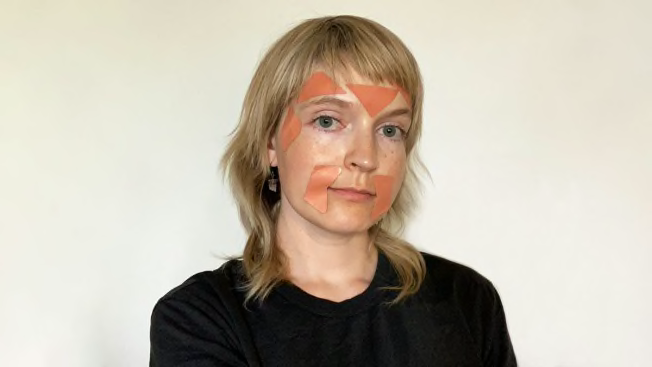Wrinkle Patches Aren’t All They’re Cracked Up to Be
Frownies and other brands of wrinkle patches promise to smooth the appearance of fine lines

By Angela Lashbrook
If you’re in the mood to terrify a loved one, wearing wrinkle patches around the house may be an excellent method. When I passed by my husband’s desk to get to my own workspace, he was shocked, although he knew it was coming; he immediately took a picture and sent it to his best friend. My coworker had a more eloquent reaction, noting that I resembled an imaginary serial killer named the “Smooth Skinned Strangler.” There is truly something unsettling about a person’s face if it’s dotted all over with vaguely skin-colored pieces of tape.
As unsettling as these products may appear, they have the very banal task of smoothing out the wrinkles beneath. Each wrinkle patch covers areas of the face where fine lines form—the space between the brows, around the lips, and framing the eyes—and, in theory, prevents lines from forming during the time in which they’re worn. I tried the Frownies brand, which is made from craft paper, though there are others that use silicone. They’re huge on TikTok, as folks on the platform look for easier, less invasive ways than Botox to smooth fine lines and “stay young.”
Unfortunately, the creepy look doesn’t result in long-lasting wrinkle prevention, though they can have a temporary effect, if you’re willing to put in the work.
As popular as wrinkle patches may be with young, smooth-faced Gen Z’s and millennials on TikTok and Instagram, they’re certainly not a new invention. Frownies, a brand-name wrinkle patch, was founded in 1889; the company’s hallmark product was originally called “Wrinkle Eradicators.” Watch any number of old movies, such as "Sunset Boulevard" (1950) or "Death Becomes Her" (1992), and find characters lounging around in dressing gowns in their boudoirs, with bits of flesh-colored tape dotting their faces.

Photo: Hulton Archive/Getty Images
Some folks swear by the products’ ability to smooth fine lines, particularly the so-called elevens that form between the eyebrows. “They make a massive difference, but only to my elevens and frown lines—I’ve not used them anywhere else,” says Becca Caddy, 35, a journalist based in the United Kingdom.
Caddy says her lines aren’t age-related, but rather appeared because she went without glasses for years and squinted instead. “I’m fully aware they’re not magically getting rid of age-related lines, but must be doing a similar thing to Botox in relaxing that area that’s usually mega-tense.”
Gwen Calais-Haase, a graduate student in Boston, found out about Frownies on TikTok. “I get so much baby Botox content that I was like, hmm, interesting alternative!” she says, referencing the trend of people in their twenties—“babies”—getting “preventative” Botox. “I was pretty dedicated [to Frownies] for three weeks” before falling off the wagon, she says.
Frownies are “similar to Botox” in that they “immobilize the underlying facial muscles through their unique design,” according to their maker. Theoretically, the patches prevent the muscles from moving, thus helping to “retrain the facial muscles to relax, release tension, and lay flat.” Other brands of wrinkle patches, such as the silicone-based SiO Beauty, work similarly, though SiO also claims that it helps the skin stay hydrated, thus “plumping” the skin and causing it to appear smoother.
Wrinkle patches require a fair amount of effort daily. Users must first wash their face, and any moisturizer must be allowed to sink in for 10 to 15 minutes before applying the patches. After massaging any fine lines for 10 to 15 seconds, the skin is ready for application. Each patch must be lightly wetted on one side. After gently separating the lines on the relevant area of the face, the user should apply the patch while pressing down with the fingers to ensure it adheres completely; the patches then harden as they dry.
Frownies recommends that people use the patches for several hours a day, preferably overnight for three to five days for shallower fine lines. Long-term results may take up to four weeks, according to the company, which advises users to wear them at least three to four nights every week to “maintain wrinkle-free skin.”
Using them is as uncomfortable as it sounds. I recently tried Frownies on my forehead and around my smile lines, and I was unable to drink water except through a straw; I couldn’t laugh, and could only mumble, as my mouth was too constricted to form words clearly. When I finally tore them off at my bathroom sink—an unpleasant experience—I was incredibly relieved. Considering that laughing, speaking, eating, and drinking all require facial movements that will inevitably result in fine lines and wrinkles, it follows that a product aimed at preventing their formation would also prevent the movements that create them. But in practice it is extremely awkward and bizarre.
“The idea of these types of products is they harden and basically stiffen, so you cannot use the muscles. So temporarily the idea is to prevent a movement, and over time to train the muscle to not move,” says Mary Stevenson, MD, an associate professor of dermatology at the New York University Grossman School of Medicine. “The results of these are temporary, and I think they’re gimmicky,” she says.
Anjali Mahto, a dermatologist based in the United Kingdom and author of "The Skincare Bible: Your No-Nonsense Guide to Great Skin" (Penguin, 2018), says she’s unaware of any data that suggests that wrinkle patches are effective. Any temporary effects “will disappear as you start to use your muscles again—a bit like an ironed piece of clothing in that it’s smooth to start with, but with wear, will become creased.”

Photos: Angela Lashbrook/Consumer Reports
I wore mine for about 6 hours and found them slightly painful to peel off, similar to a Band-Aid that’s very well-adhered. Unlike a Band-Aid, though, the patches don’t leave noticeable residue. Frownies directions say that the patches should be “thoroughly soaked” to remove, which may have accounted for the discomfort I experienced tearing them off. I didn’t want to take a shower at 6 p.m. before walking my dog, so I washed my face at the sink instead, which made me wonder if perhaps I wasn’t quite “soaking” the patches to the extent that they required.
Frownies recommends that people wear several days’ worth of patches before expecting results, which likely accounts for why my elevens and smile lines were as obvious after patch removal as they were before. I did receive a fun surprise in the form of new face lines where the patches dug into and creased my skin at the edges (similar to a pillow crease); these lasted about an hour and a half. I was careful not to apply the patches over my eyebrows, as Frownies warns specifically that patches placed over hair can remove it.
Though I didn’t have much success—and clearly looked even more creased after trying them—other people may discover that, with enough advance preparation, these could be helpful before a big event. To use Mahto’s analogy, just as you might iron out a shirt before going on a date, you could “iron out” your fine lines before a party, as well. But because wrinkle patches must be worn at least for several hours a day for three to five days in a row, this would require quite the preparation indeed for a temporary effect.
Frownies acknowledges the temporary nature of the products’ effects to a certain extent, writing in the instructions section of the website that lines may reappear depending on facial movements or environmental stressors, but that results will last longer with consistent application.
Folks who want to reduce the appearance of fine lines will likely get better results with retinol, a vitamin A derivative that encourages skin cells to turn over and die (this is a good thing) so that fresh young cells can grow in their place. Retinol creams are available over the counter and contain up to 2 percent retinol. More potent vitamin A formulas known as retinoids are typically available only with a prescription.
The most effective results can be achieved via medical-grade skin care products, neurotoxins, and in-office procedures, according to Stevenson. Your dermatologist may offer anti-aging treatments or may be able to refer you to a dermatologist who specializes in cosmetic dermatology. Available neurotoxins include Botox, Dysport, and Jeuveau, and though they’re relatively expensive, the results typically last between three to four months (talk to your doctor about potential side effects before getting injections). Laser resurfacing, chemical peels, and microneedling are in-office procedures that can improve the look of the skin by reducing or refining the appearance of sunspots, scars, fine lines, and wrinkles.
Personally, I’ll be sticking with my low-dose prescription retinoid, which is cheap, easy to apply, and doesn’t make me look like a serial killer. Whatever lines push through in spite of my simple nightly routine will be cherished—or, at the very least, tolerated. I’ve lived and will continue to live a very interesting life. Why not let some of that evidence bloom on my face?
Consumer Reports is an independent, nonprofit organization that works side by side with consumers to create a fairer, safer, and healthier world. CR does not endorse products or services, and does not accept advertising. Copyright © 2022, Consumer Reports, Inc.